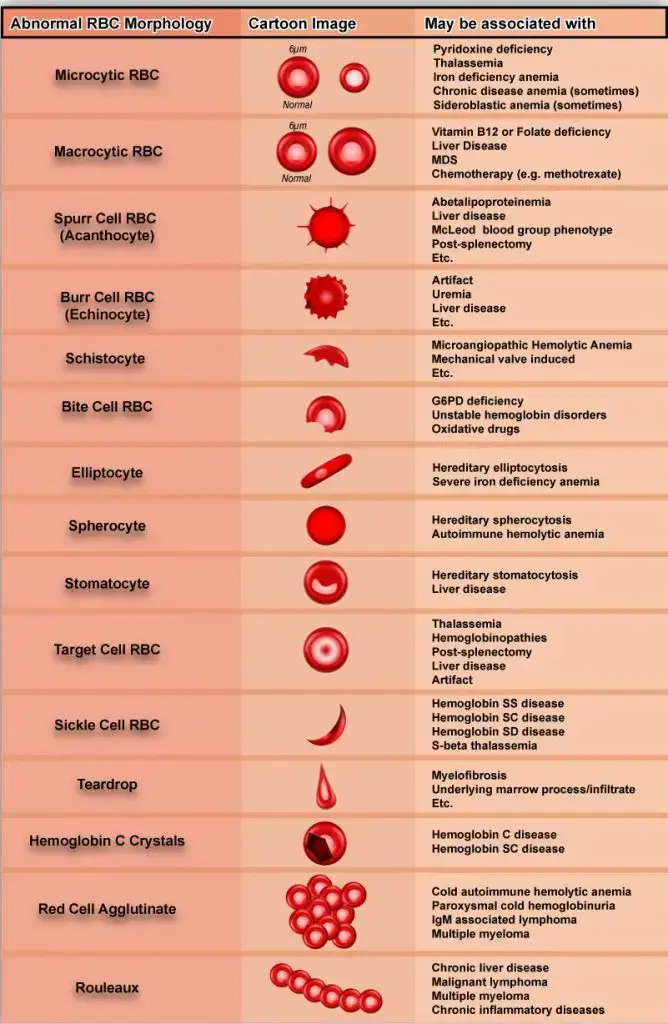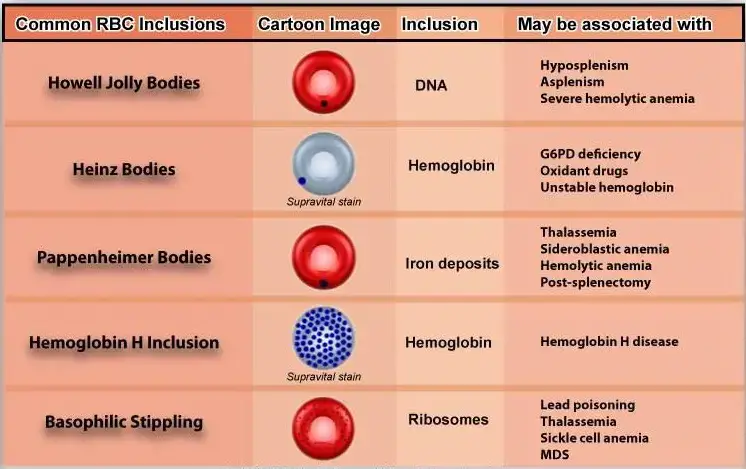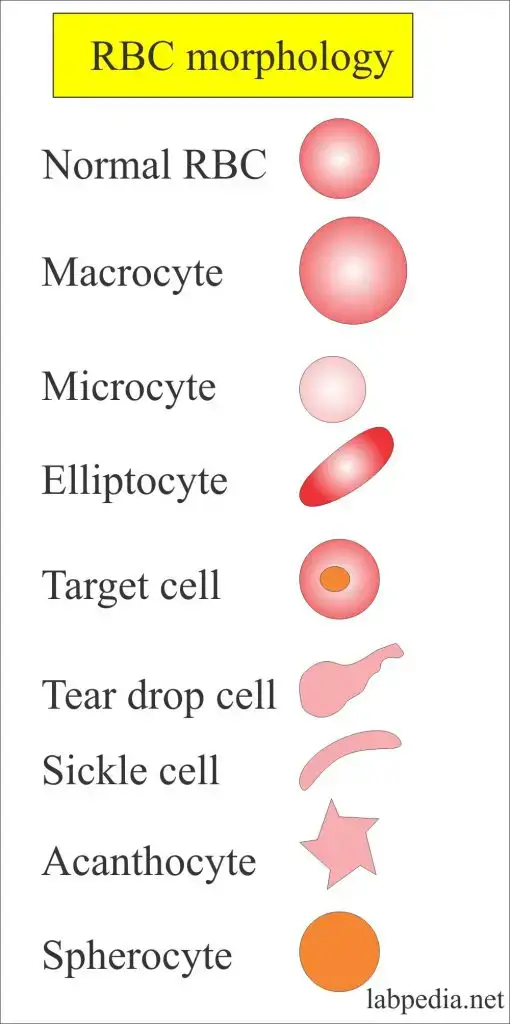Red blood cells constitute the primary cellular component in blood. Red blood cells that are mature are biconcave discs which have no nucleus and are devoid of most cell organelles , including the lysomes, endoplasmic-reticulum and mitochondria.
However, a variety of abnormal erythrocyte morphology can be seen in a variety of medical conditions:
- Anisocytosis: Variation of size
- Poikilocytosis: Variation of shape
- Color variation
- The presence of inclusion bodies
Anisocytosis: Variation in size
The variation in dimensions of RBC is known as anisocytosis. The typical dimension of RBC is 7.5+/-0.2 micrometers in diameter. Small lymphocyte nucleus can be an excellent indicator of how big is RBC. Anisocytosis can be classified into Macrocytosis and Microcytosis.
- Microcytosis: RBCs less than normal are thought to be microcytes. The signs of microcytosis are found in iron deficiency anemia, lead poisoning, thalassemia, sideroblastic anemia, and anemia of chronic disorders.
- Macrocytosis: RBCs that are larger than normal in size are thought to be macrocells. Macrocytosis is a sign of Hypothyroidism, liver diseases, megaloblastic anemia, post splenectomy, and other reasons for an elevated erythropoiesis.

Variation in color
RBCs that look disc-shaped and have a central pallor, which is about 1/3 of the cell’s circumference (containing normal amounts of hemoglobin) are classified as normal-chromic RBCs.
Hypochromic: RBCs with an appearance which is larger than normal are referred to as hypochromic. This type of variation can be seen in Iron deficiency anemia, chronic illnesses, thalassemia certain hemoglobinopathies, sideroblastic anemia, or any of the circumstances that cause microcytosis.
Poikilocytosis: Variation in shape
The shape and form of RBCs is known as poikilocytosis. RBCs are biconcave discs within large blood vessels , however their shape alters to parachutes like capillaries.
Here are some unusual RBC shapes:

Spherocytes
- RBCs are not biconcave and become more spherical. there is no central pallor due to the increased hemoglobin content.
- Spherocytes can be found in spherocytosis hereditary, hemolytic anemia, and post-transfusion reaction.
Ovalocytes
- Oval-shaped RBC.
- Ovalocytes can be found in Thalassemia major and hereditary ovalocytosis. They are also found in sickle cell anemia.
Elliptocytes
- The RBCs are oval or elliptical the long axis is double the short axis.
- Elliptocytes can be found in megaloblastic anemia and elliptocytosis. IDA Myelofibrosis, Thalassemia, myelofibrosis.
Target cells
- Red cells are characterized by an area of enhanced staining that appears in the area of the central pallor.
- Target cells can be found in obstructive liver disorders such as severe IDA, Thalassemia, Hemoglobinopathies, post splenectomy.
Teardrop cells
- RBCs have the form of a teardrops or pear. They are typically microcytic and usually hypochromic.
- Teardrop cells are present in megaloblastic anemia, myelofibrosis, IDA, thalassemia.
Schistocytes
- They are triangular or helmet shape, distorted or distorted RBCs , smaller than normal sizes.
- Schistocytes can be seen in Thalassemia Microangiopathic hemolytic Anemia and mechanical hemolytic anemia. artificial heart valves, uremia.
Acanthocytes
- RBCs with projections that are irregularly spaced. The projections vary in size, however, they usually have the rounded ends.
- Acanthocytes can be found in liver disorders, post splenectomy, anorexia and starvation in alcoholism, vitamin C deficiencies.
Stomatocytes
- Red cells that have an oblique slit in the middle or stoma. They are seen as a mouth-shaped structure in the peripheral smear.
- Stomatocytes are seen in excessive alcoholism, liver diseases caused by alcohol and heref=ditary stomatocytosis.
Keratocytes
- They are half moon-shaped cells that have two or more spikes.
- Keratocytosis is a sign of patients with G6PD insufficiency or pulmonary embolism and disseminated intravascular bleeding.
Burr cells
- Red cells that have uniformly dispersed pointed projections on the surface of their cells.
- Burr cells can be found within hemolytic anemia and uremia and megaloblastic anemia.
Sickle cells
- These are sickle-shaped Red Blood Cells.
- Sickle cells are found in Hb-S disease/ sickle cell anemia.
Red cell agglutinate
- They are clumps that have irregular shapes made of RBCs.
- They are seen in cold agglutinations as well as warm immune hemolysis.
Rouleaux Formation
- Stacks of RBCs that resemble a stack of coins.
- These are found in hyperglobulinemia, hyperfibrinogenaemia.
Presence of Inclusion Bodies
Red blood cells can have various forms and morphologies, which depend on type of inclusion bodies such as:

- Howell-Jolly bodies: Small round red cell inclusions in the cytoplasm that have similar staining characteristics to nuclei. These are DNA fragments. They are typically found within Post Splenectomy MBA or hemolytic anemia.
- Heinz bodies: They represent hemoglobin denatured (methemoglobin) inside cells. By using a supravital stain, such as the crystal violet stain, Heinz bodies appear as small blue crystals. They are typically found within G6PD Deficiency, splenectomy.
- Pappenheimer bodies: They are iron deposits, which are blue irregular granules that appear in the stain called wright. Pappenheimer body structures are present in RBCs with hemolytic anemia in splenectomy and sideroblastic anemia as well as Thalassemia.
- Basophilic stippling: These are a large number of tiny basophilic inclusions inside red cells that represent the RNA that has been precipitated. They are seen in thalassemia MBA, hemolytic anemia, liver damage, and heavy metal poisoning.
- Cabbot’s ring: Reddish thread-like rings, purple, within RBCs of anemias that are severe. These are remnants of the nuclear membrane.
- Parasites of red cells: Protozoan parasites like one of the four species of malarial parasite are often seen when there is a malarial infection.
Different Size and Shape of Red Blood Cell
| RBC morphology | Lab findings | Causes |
| Microcytosis | RBC diameter <6 µm MCV < 80 fl MCHC < 27% | Iron deficiency anemia Anemia due to chronic diseases Thalassemia |
| Macrocytosis | RBC diameter > 8 µm | Megaloblastic anemia |
| Hypochromic | RBC has a central pallor area | Decreased Hb contents Iron deficiency anemia |
| Poikilocytosis | RBC has variable shapes | Sickle cell anemia Leukemias Microangiopathic hemolysis Extramedullary hematopoiesis |
| Anisocytosis | RBC has a variable size | Reticulocytosis Blood transfusion into microcytic or macrocytic anemia |
| Spherocytosis | RBC has no biconcavity RBC has no central pallor MCHC is high | Hereditary spherocytosis Loss of cell membrane relative to cell volume |
| Acanthocytosis | RBC has spiculated surface | Liver diseases Abetalipoproteinemia |
| Elliptocytosis | RBCs are an oval | Hereditary defect This is usually harmless |

- Text Highlighting: Select any text in the post content to highlight it
- Text Annotation: Select text and add comments with annotations
- Comment Management: Edit or delete your own comments
- Highlight Management: Remove your own highlights
How to use: Simply select any text in the post content above, and you'll see annotation options. Login here or create an account to get started.